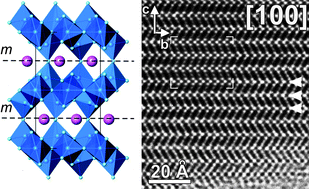BiMnFe2O6, a polysynthetically twinned hcp MO structure†
Abstract
The most efficient use of spatial volume and the lowest potential energies in the metal

* Corresponding authors
a
Department of Chemistry and Chemical Biology, Rutgers, the State University of New Jersey, 610 Taylor Road, Piscataway, NJ, USA
E-mail:
martha@rutchem.rutgers.edu
Tel: +732-445-3277
b Electron Microscopy for Materials Research (EMAT), University of Antwerp, Groenenborgerlaan 171, Antwerp, Belgium
c Racah Institute of Physics, The Hebrew University, Jerusalem, Israel
d Department of Physics and Astronomy, Stony Brook University, Stony Brook, NY, USA
e II. Physikalisches Institut, Universität zu Köln, Zülpicher Str. 77, Köln, Germany
f Max Planck Institute for Chemical Physics of Solids, Dresden, Germany
g Department of Chemistry and Physics, Rowan University, Glassborough, NJ, USA
h Department of Physics and Astronomy, Rutgers, The State University of New Jersey, 136 Frelinghuysen Road, Piscataway, NJ, USA
i Materials Science and Engineering Department, Rutgers University, Piscataway, NJ, USA
j Inorganic & Structural Chemistry and Berzelii Centre EXSELENT on Porous Materials, Stockholm University, Stockholm, Sweden
The most efficient use of spatial volume and the lowest potential energies in the metal

 Please wait while we load your content...
Something went wrong. Try again?
Please wait while we load your content...
Something went wrong. Try again?
T. Yang, A. M. Abakumov, J. Hadermann, G. Van Tendeloo, I. Nowik, P. W. Stephens, J. Hemberger, A. A. Tsirlin, K. V. Ramanujachary, S. Lofland, M. Croft, A. Ignatov, J. Sun and M. Greenblatt, Chem. Sci., 2010, 1, 751 DOI: 10.1039/C0SC00348D
To request permission to reproduce material from this article, please go to the Copyright Clearance Center request page.
If you are an author contributing to an RSC publication, you do not need to request permission provided correct acknowledgement is given.
If you are the author of this article, you do not need to request permission to reproduce figures and diagrams provided correct acknowledgement is given. If you want to reproduce the whole article in a third-party publication (excluding your thesis/dissertation for which permission is not required) please go to the Copyright Clearance Center request page.
Read more about how to correctly acknowledge RSC content.
 Fetching data from CrossRef.
Fetching data from CrossRef.
This may take some time to load.
Loading related content
